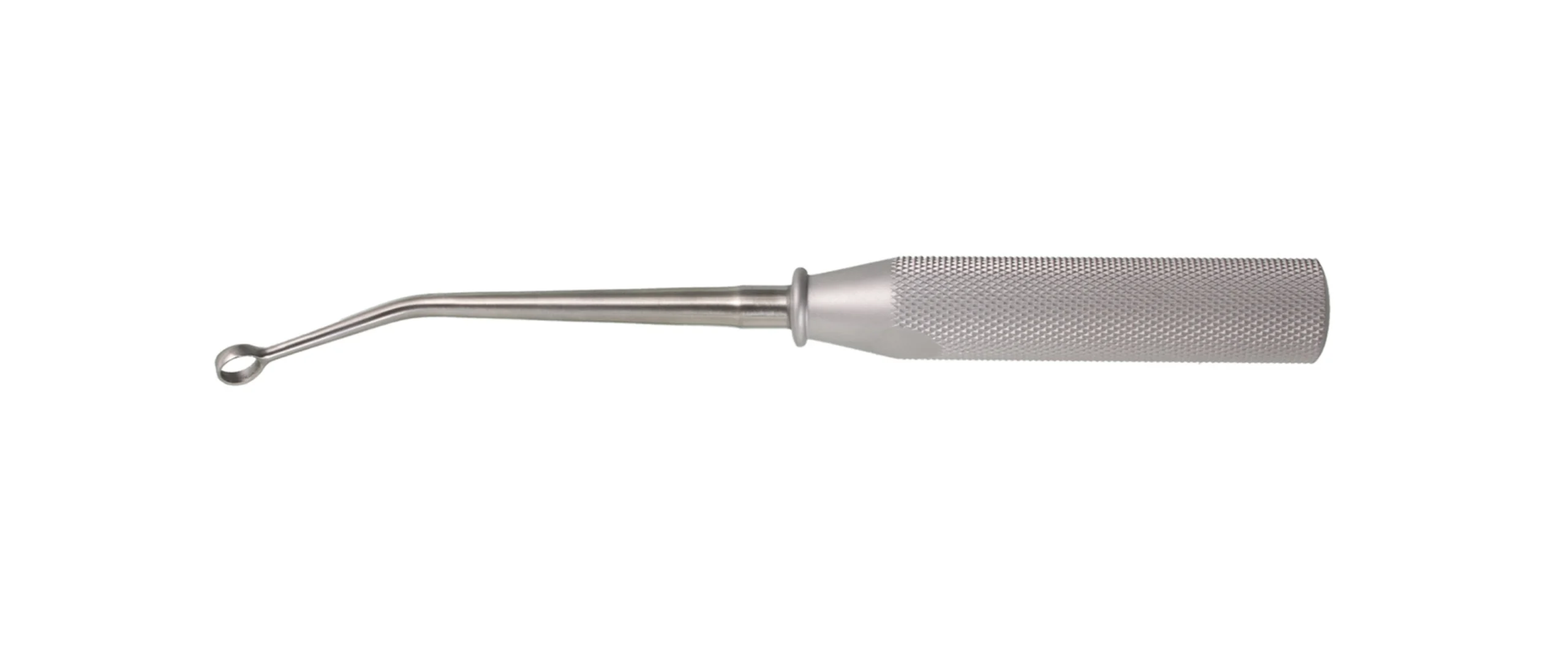- General Surgery Instruments
- Orthopedic & Spine
- Neurosurgical
- Electrosurgical
- Non-Stick Bipolar Forceps
- European Irrigation Bipolar Forceps
- Monopolar Cables
- USA 2 Pin Bipolar Forceps
- European Non-Stick Bipolar Forceps
- Bipolar Artery Sealer
- Diathermy Instruments
- Bipolar Electrodes
- Disposable Bipolar Forceps
- Electrodes 4.0mm
- Electrosurgical For Gynecology
- European Bipolar Forceps
- Gynecology
- ENT
- Cardiovascular
American Ring Curettes

American Ring Curettes are a type of curette characterized by a complete circular (ring-shaped) cutting edge at the tip. Essentially, the working end of the instrument forms a ring or loop that is sharp on the inner edge, allowing it to cut or scrape when drawn across tissue. This design is part of the American-pattern curettes and is particularly useful for circumferential scraping – it can remove tissue in any direction of movement due to the 360-degree cutting surface. In orthopedic and spine surgeries, American Ring Curettes are commonly used for scooping out disc material, removing tissue from within bony cavities, or excising lesions, offering surgeons excellent control and the ability to modulate pressure evenly around the ring.
Key Features and Benefits
- 360° Cutting Loop: The ring curette’s tip is a complete loop, providing a full-circle cutting edge. This means no matter how the surgeon angles or rotates the instrument, a portion of the edge is in contact with the tissue, allowing continuous scraping. It’s especially effective for encircling and removing tissue masses (like disc fragments or cysts) because the ring can capture and cut around them.
- Different Ring Diameters: American Ring Curettes come in various diameters (for example, 3mm, 5mm, 7mm rings, etc.), enabling the surgeon to choose the appropriate size for the task. A small ring is perfect for tight spaces and precise removal, whereas a larger ring covers more area. The variety ensures flexibility – a surgeon can sequentially use multiple ring curettes, starting with larger to clear bulk tissue and finishing with smaller for fine cleanup.
- Rigid Shank with Angled Options: Many ring curettes have slight angle bends (e.g., 15° up or down) near the tip to improve access to certain areas, like the interior of an intervertebral disc or a bone cavity. The shank is rigid stainless steel, transmitting force effectively to the ring tip. Angled ring curettes allow the hand to stay out of the line of sight while the ring reaches around corners or into recesses.
- Tactile Feedback and Control: The closed ring design provides excellent feedback; as the curette scrapes, the surgeon can feel resistance uniformly around the loop. This helps judge the consistency of the material being removed (soft disc vs. harder bone). Additionally, because the ring encloses tissue as it cuts, there’s less chance of the instrument slipping off the tissue suddenly – giving a measure of safety and control during delicate maneuvers.
- Efficient Tissue Removal: When rotated or swept, the ring curette can efficiently scoop out tissue in one motion that might otherwise require multiple passes with a straight-edge curette. It tends to collect the removed material within the ring, which makes extraction of the debris easier – the surgeon can often pull the instrument out and bring the removed tissue with it. This efficiency is beneficial for maintaining a clear surgical field.
Surgical Applications
In intervertebral disc surgery (like cleaning out the disc space in a discectomy or preparing it for fusion), American Ring Curettes are extremely useful. A surgeon can insert the ring into the disc space and rotate or pull it to scrape out remnants of nucleus pulposus or annular tissue. The ring shape conforms well to the space and can often reach both sides of the disc space with a single instrument. The result is a thoroughly cleaned disc space, which is important for relieving nerve pressure and ensuring good contact for a fusion cage or bone graft.
For bone cysts or benign tumors (such as a giant cell tumor cavity in bone), after the bulk of the lesion is removed, ring curettes help scrape the walls of the cavity to ensure no residual tumor cells remain. The full circular edge is adept at stripping the lining off the cavity wall. Orthopedic surgeons use progressively smaller ring curettes to systematically clear out such cavities, reducing recurrence rates by performing an aggressive yet controlled curettage.
Surgivalley’s American Ring Curettes are made with precision engineering – the rings are perfectly shaped and sharpened, and securely attached to the handle without weak points. Each instrument is balanced for ease of use, meaning surgeons can maneuver them for extended periods without undue hand strain. They are also built to last, retaining their sharpness through many surgeries.
Cleaning is straightforward as the ring is open (no fine teeth or hidden recesses), and the instrument can be sterilized repeatedly with no degradation in quality. We offer ring curettes individually or as sets so that surgical teams have every size needed at their disposal. By incorporating the American Ring Curettes from our [Curettes] collection into your surgical armamentarium, you equip yourself with a highly effective tool for thorough debridement and tissue removal, all backed by Surgivalley’s commitment to quality and surgical excellence.


